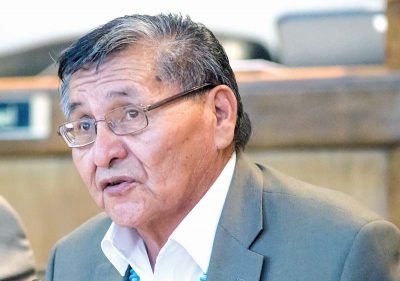
Guest Column | A short history of the Navajo Tribal Council
By Ben Shelly
Editor’s note: Mr. Shelly is a retired politician who served as the seventh president of the Navajo Nation from January 2011 to May 2015. Mr. Shelly is Tó’aheedlíinii and born for Ts’ah Yisk’idnii.
The moment to commemorate the centennial of the Navajo Nation Council slipped by us last January 2022. The Navajo Tribal Business Council first convened on Thursday, in Fort Defiance, on Jan. 26, 1922.

Navajo President Ben Shelly gives his State of the Nation speech on Monday, Jan. 26, 2015, during Winter Session in Window Rock. (Times photo – Donovan Quintero)
The three-member Council approved three oil and gas leases in the Fort Defiance Agency. The federal government was compelled to obtain consent from the Navajos. The state of Arizona initially approved the leases in March 1913. Formal assent was necessary.
The government’s solution was to create a business council to appease the satisfaction of securing approval. As best described by Dan Vicenti, retired tribal planner and court advocate, the Council is a fabrication of the BIA. The first order of business following its creation and the appointment of its three members was to approve oil and gas leases. No other business was on the agenda that day.
The next business for the Council occurred 18 months later, in 1923, to give the Interior Department consent for oil and gas mining and leasing on the “Navajo Treaty Reservation.” The action was based on a law Congress passed in 1891 that gave tribes consent to lease land.
A year later, in 1924, the Council was approved to meet again to establish common ownership of oil for all members to share in the benefits.
In 1925, two more measures on oil and leasing were approved. The first was to make a change from the five-year leasing period for oil to 10 years for the Midwest Oil lease in Hogback. The next measure gave consent to the sale of a lease in Beclabito for oil. After the two oil and leasing matters were approved that day, an action to apportion (distribute) funds in 12 ways was approved: four parts for the Navajo area, two for San Juan, two for western, one for Crownpoint, one for Leupp, and one for Keams Canyon areas.
The following day, and final day of business that year, the Council took up its first non-oil and leasing consideration. It established that “Navajo children from high altitudes to lower climates is not suitable for health” reasons and disallowed transfers of any child below the seventh grade. The same action established higher education and better industrial training to be taught. The Albuquerque Indian School was designated as the finishing school for advanced Navajo boys and girls, and that students be permitted to attend any white school.
The Navajo Tribal Business Council began with its three members. It later changed to 24 members, followed by 74, 87, 88, and back to 24.
In 1938, the Navajo Tribal Business Council was dissolved. It occurred after the first election by the populace, in which the people voted to elect councilmen and the chairman and vice chairman. All members of the Tribal Council prior to were appointed by the BIA. The day following the dissolvement of the Council, the newly established Council asked the Commissioner of Indian Affairs for permission to meet any time between December through January 1939. The Council met seldom and only when authorized by the BIA, usually once a year.
During this era, the U.S. government invoked tribes to adopt constitutions as part of the Indian Reorganization Act of 1934. In June, the Navajo people defeated the acceptance of Indian Reorganization and, by such, kept the Treaty of 1868. Four more attempts to adopt a constitution by the Navajo people and the Navajo Tribal Council took place in 1936, 1937, 1953, and 1968. All were unsuccessful.
In 1989, the Navajo Tribal Council amended Title Two, that created a three-branch government. It declared that the Navajo Nation Council, as it was renamed, is the “governing body of the Navajo Nation.” The Title Two amendments were said to be temporary until the Navajo people decide on a permanent form of government.
The Navajo Nation Council has grown in its authority, and the Navajo Nation has recognized and accepted political sovereignty. What needs to be achieved is economic sovereignty and self-sustaining power to someday end federal dependency.








 Highway 264,
Highway 264, I-40, WB @ Winslow
I-40, WB @ Winslow